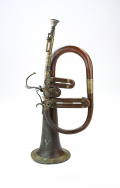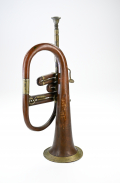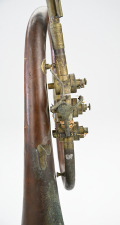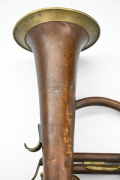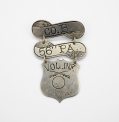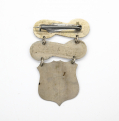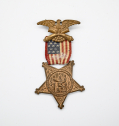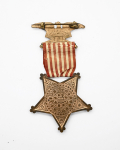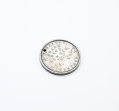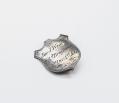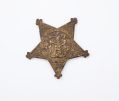site search
online catalog
CIVIL WAR MUSICIAN’S GROUPING INCLUDING WARTIME IDENTIFICATION DISK, IDENTIFICATION SHIELD, AND FREEMANTLE ROTARY VALVE CORNET/VALVED BUGLE: JOHN J. WEAVER- 10th and 56th PA- AND CUTLER’S BRIGADE BAND 1861-1865
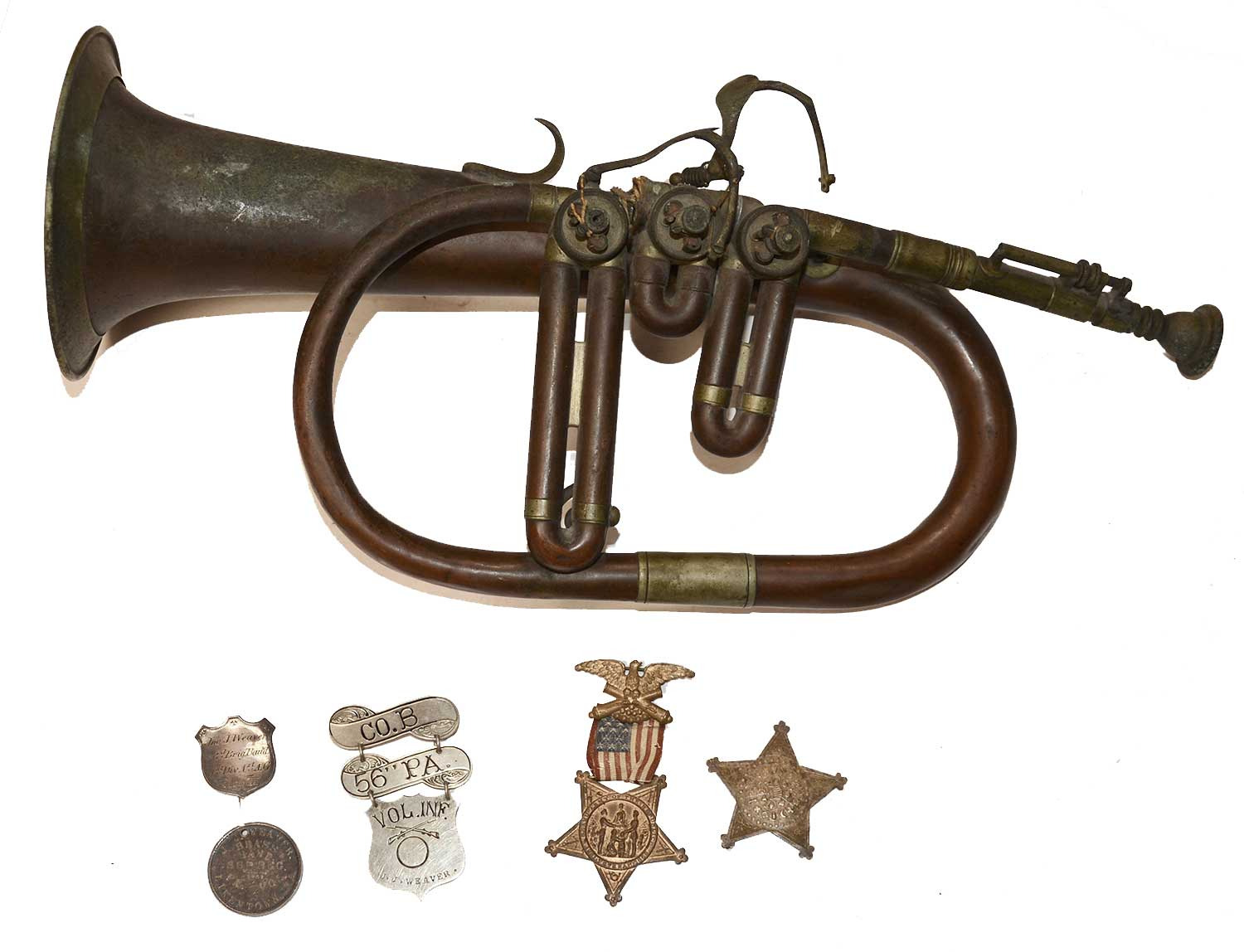
$8,500.00
Quantity Available: 1
Item Code: 1179-420
Shipping: Determined by Method & Location of buyer
To Order:
Call 717-334-0347,
Fax 717-334-5016, or E-mail
This wonderful grouping includes two wartime identification badges, a rotary valve cornet dating about 1864, along with his GAR membership badge and veteran’s id badge. To top it off, in addition to prior service in the 10th PA from April 26 to July 31, 1861, the soldier served in the regimental band of the 56th Pennsylvania and then in the band of Cutler’s brigade from January 7, 1862, to June 6, 1865. Both the regiment and the brigade were hard-fighting units, with the brigade perhaps best remembered as the first Union infantry entering the fray at Gettysburg, taking heavy casualties on July 1 fighting Davis’s brigade and helping delay the Confederate advance and then playing an important part in holding Culp’s Hill on July 2, losing 14 killed, 61 wounded, and 55 missing in the battle out of just 252 engaged.
The group consists of six pieces: A) Weaver’s wartime identification disk as a member of the 56TH PA band; B) his wartime identification shield as a member of the brigade band; C) his ca. 1864 rotary valve cornet (or flugelhorn/valved bugle) by Freemantle of Boston; D) his GAR membership badge; E) his veteran’s identification badge as a member of Co. B 56th PA; F) a loose planchet for a GAR membership badge.
Weaver had first served in the three-month 10th PA Volunteers as Principal Musician, as confirmed by the PA CW Veterans Index, though carried on the books as a private in Co. F. A similar arrangement seems to have taken place in the 56th PA, where is listed as member of Co. B, but as his identification disk makes clear, served in the regimental band. His pension index card for this service gives his enlistment as January 7, 1862. His identification disk is the the Washington bust type, in white metal, in excellent condition with sharp details. This #3a in Maier and Stahl’s catalog, struck from a die made by J.H. Merriam having with a roped inner border and bust of Washington with his name and birthdate in raised letters on one side and the other stamped in small letters at center “WAR OF 1861,” with Weaver’s details added in larger letters: “J.J. WEAVER / BRASS BAND / 56th REG. / PA. VOL./ LIKENTOWN. PA.” This the town of Lyken in Dauphin County, where weaver is picked up in the 1860 census as a carpenter and listed on his enlistment in the 10th PA as a cabinet maker.
Weaver’s second wartime badge is a small T-bar backed identification shield with a finely detailed impressed border with floral ornaments in the upper recesses of the scalloped top edge and at the lower point, with “WAR OF 1861” impressed at the bottom in small block letters and “Jno. J. Weaver / 2d Brig. Band / 1st Div. 1st A.C.” engraved at center with flourishes at left and at bottom. This likely dates to Fall 1862 when, as a cost-cutting measure, the government abolished regimental bands. A few units seem to have retained them by some means, but officially they were only sanctioned at brigade level and above. Serving in the brigade band then pulls him out of published regimental rolls because, as his pension index card makes clear, he was then considered a member of the U.S. Volunteers, and explains why he seems to vanish from Bates’s regimental roster, which is based on imperfect muster-out rolls in any case. His continued service on the rolls as a U.S. Volunteer is guaranteed by his pension index card, which shows him mustering out only on June 6, 1865, the period when the various regiments of the brigade were mustering out, including the 56th PA in July and the last brigade commander’s duty ending on June 28.
We have called Weaver’s horn a cornet for shorthand, but more those more knowledgeable might classify it as a flugelhorn or valved bugle. (Our copy of Garofalo and Elrod has made several circuits around the office, and debate is still raging.) It is copper with brass floating garland and ferrules and three string rotary valves. The condition is very good, with a great, untouched patina. There are some small dents on the lower rear loop of the tube and the rotary valves need work, but we feel the value and significance of this horn is its identification to Weaver, its untouched condition and historical record, and we would leave it as is. It is engraved in script above the bell: “G. Freemantle / Maker / Boston / late of Graves & Co.”
Samuel Graves was working as a musical instrument maker in Boston at least by 1853 and through the Civil War operated in several different partnerships and under differing company names. George Freemantle (Sr.) emigrated to Boston about 1838 and is sometimes confused with his son George (Jr.,) who was also involved in the music business, as musician, teacher, dealer, etc., though whether as much a maker of instruments as his father is unclear. In any case, the best information indicates the elder Freemantle worked at the same address as E.G. Wright and as Graves & Co. from 1858, and continued there after Wright left in 1860. He is listed as a shop foreman early on and then as a partner in Graves & Co., which may have come about after Wright left. Freemantle then remained in that location after Graves left, which occurred by 1864. He seems to have changed location and gone to work with E.G. Wright in 1865, which would likely end his advertising as “late of Graves & Co.” and provide an outer date for this instrument.
Weaver’s veteran’s badge is 3-piece construction with two upper scroll shaped bars suspending a lower shield-shape badge by small chains, all with cast or impressed designs. The upper bar has the spring pin in place and reads “CO. B;” the second bar, “56” PA.; and the shield bears an stamped “VOL. INF.” over crossed rifles and the disk insignia of the First Army Corp, with “J.J. Weaver” stamped in smaller letters at bottom. His GAR membership badge is the Type-V, with patent dates and campfire and camp kettle on the reverse of the upper pin and the badges of Sheridan’s, Wilson’s, and Hancock’s Veteran Corps added to the reverse lower points of the star. The badge is in very good condition with substantial gilt remaining, but with some fading and wear to the ribbon, which is nevertheless still solid. The loose planchet is the same pattern, but showing wear and darker patina, likely replaced when the missing suspension bar broke, but retained as a memento.
We have not pulled Weaver’s service and pension records, and we do not see him on the PA Gettysburg Monument, but would not expect to since he was then in the U.S. Volunteers, but his service with the 56th and in the brigade band would likely follow the Dyer’s summary for the regiment, where bandsmen were generally assigned to aid medical personnel in the evacuation and treatment of wounded, frequently under fire:
Left Pennsylvania for Washington, D.C., March 8. Duty at Fort Albany, defenses of Washington, until April 4, 1862, and at Budd's Ferry until April 24. At Aquia Creek Landing until May 10. Guarded the railroad bridge at Potomac Creek May 21–27. (Five companies moved to Belle Plains May 10.) Guard duty near Fredericksburg until August 9. Pope's Campaign in northern Virginia August 16 – September 2. Battles of Gainesville August 28; Groveton August 29; Bull Run August 30. Maryland Campaign September 6–24. Battles of South Mountain September 14; Antietam September 16–17. Duty on the battlefield of Antietam until October 20. (Company A at Fairfax October 20–30.) At Bakersville October 20–30. Movement to Falmouth, Va., October 30 – November 19. Union, Va., November 2–3. Battle of Fredericksburg December 12–15. Burnside's 2nd Campaign, "Mud March," January 20–24, 1863. At Falmouth and Belle Plains until April 27, 1863. Chancellorsville Campaign April 27 – May 6. Operations at Pollock's Mill Creek April 29 – May 2. Fitzhugh's Crossing April 29–30. Chancellorsville May 2–5. Brandy Station and Beverly Ford June 9. Gettysburg Campaign June 11 – July 24. Battle of Gettysburg, July 1–3. Pursuit of Lee July 5–24. Duty on line of the Rappahannock until October. Bristoe Campaign October 9–22. Advance to line of the Rappahannock November 7–8. Mine Run Campaign November 26 – December 2. Demonstration on the Rapidan February 6–7, 1864. Veterans on furlough March 10 – April 17. Rapidan Campaign May 4 – June 12. Battles of the Wilderness May 5–7; Laurel Hill May 8; Spotsylvania May 8–12; Spotsylvania Court House May 12–21. Assault on the Salient May 12. North Anna River May 23–26. Jericho Ford May 25. Totopotomoy May 28–31. Cold Harbor June 1–12. Bethesda Church June 1–3. Before Petersburg June 16–18. Siege of Petersburg June 16, 1864 to April 2, 1865. Mine Explosion, Petersburg, July 30, 1864 (reserve). Weldon Railroad August 18–21. Poplar Springs Church September 29 – October 2. Boydton Plank Road, Hatcher's Run, October 27–28. Warren's Raid on Weldon Railroad December 7–12. Dabney's Mills, Hatcher's Run, February 5–7, 1865. Appomattox Campaign March 28 – April 9. Lewis Farm near Gravelly Run March 29. Boydton and White Oak Road March 31. Five Forks April 1. Fall of Petersburg April 2. Appomattox Court House April 9. Surrender of Lee and his army. March to Washington, D.C., May 2–12.
During their service the regiment lost 7 officers and 111 enlisted men killed or mortally wounded, and many more who were wounded or maimed, but survived. Weaver made it home and died in California in 1916. He had married and lived with his wife and family for some years in Lafayette, Indiana, apparently moving to California after the death of his wife in 1912 and was living with or near one of his stepdaughters when he passed away in Long Beach, where he was a member of the local GAR Post. [sr][ph:m]
~~~~~~~~~~~~~~~~~~~~~~~~~~~~~~~~~~~
THIS ITEM, AS WITH ALL OTHER ITEMS AVAILABLE ON OUR WEB SITE,
MAY BE PURCHASED THROUGH OUR LAYAWAY PROGRAM.
CLICK HERE FOR OUR POLICIES AND TERMS.
THANK YOU!
Inquire About CIVIL WAR MUSICIAN’S GROUPING INCLUDING WARTIME IDENTIFICATION DISK, IDENTIFICATION SHIELD, AND FREEMANTLE ROTARY VALVE CORNET/VALVED BUGLE: JOHN J. WEAVER- 10th and 56th PA- AND CUTLER’S BRIGADE BAND 1861-1865
For inquiries, please email us at [email protected]
Most Popular
Historical Firearms Stolen From The National Civil War Museum In Harrisburg, Pa »
Theft From Gravesite Of Gen. John Reynolds »
Cavalry Carbine Sling Swivel »
Fine Condition Brass Infantry Bugle Insignia »
featured item
FANTASTIC FRAMED DRAWING OF THE BATTLE OF DRAINSVILLE DONE BY GETTYSBURG CARTOGRAPHER EMMOR B. COPE
This wonderful and detailed drawing shows the meeting engagement on December 20, 1861 between a brigade of Pennsylvania Reserve regiments under Brig. Gen. E. O. C. Ord and a mixed Confederate force led by Gen. J. E. B. Stuart. The scene was drawn by… (1054-2733). Learn More »




